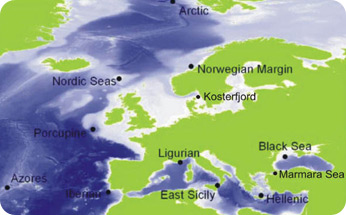Off the coast of Norway, a mile-wide volcano spits out mud and methane -- a greenhouse gas that could increase global warming. Near the Azores islands, “chimneys” pump 500-degree water into the Atlantic, feeding colonies of algae, shrimp, and other organisms. And beneath the Sea of Marmara, an active fault line triggers deadly earthquakes across Turkey.
 Proposed ESONET locations. Credit: ESONET
Proposed ESONET locations. Credit: ESONETEuropean scientists hope to get a much better look at these and other marine environments with a network of 11 underwater observatories known as ESONET. They’ll be placed all around Europe -- in the Arctic, Atlantic, Mediterranean, and the Black Sea.
Scientists are planning several types of observatories. Some would be based on the ocean floor. Others would be attached to anchored buoys, allowing them to monitor conditions from the surface to the bottom. And still others might be mobile. All of them would transmit their readings through fiber optic cables, or through orbiting satellites.
The observatories should keep an eye on just about everything. They’ll monitor water temperature, salinity, and currents. They’ll listen for earthquakes, and watch for submarine landslides. They’ll count fish and other organisms. And perhaps most important, they’ll operate for years, allowing scientists to detect changes caused by global warming or other factors.
ESONET will cost hundreds of millions of dollars, and take years to complete. But when it’s done, it’ll provide the most complete picture yet of conditions under the sea.

